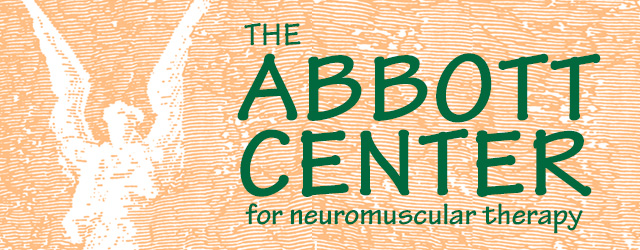Pain Relief with Massage, Pilates and Neuromuscular Therapy • Open 7 Days • Gift Certificates Available Online 24/7
Equipment or Mat?
Private and semi-private lessons are ideal for beginners learning on mats and on apparatus with interesting names like the Reformer, Cadillac and Wunda Chair. For more advanced students there are never-ending challenges. You can work alone as a Solo or come with a friend for Duets. To cut costs, Trios and small group classes are available and we offer series packages at discounted rates.
Private lessons are conducted on the apparatus, on floor mats and in standing positions. Springs are attached to a gliding platform, a pedal, straps, bars and suspended apparatus to create resistance. The opposition makes your muscles work harder and increases strength with length more quickly than conventional workout routines. When you go to the mat, you transfer those sensations of opposition from the springs to make your floor work more effective. On the floor, gravity becomes the resistance. The teacher may introduce the Magic Circle, light weights, balls, a foam roller or resistance bands to challenge you in different ways.
Pilates first developed equipment for rehabilitating bedridden hospital patients. He rigged apparatus for strengthening out of plumbing pipes and bedsprings and straps since no gym equipment was available to him. He said, “Look, you see it resists your movements in just the right way so those inner muscles really have to work against it. That way you can concentrate on movement. You must always do it slowly and smoothly. Then your whole body is in it.” He continued to develop several pieces of equipment with the same purpose.
The Six Principles
It was Pilates’ firm belief that practicing his method, “develops the body uniformly, corrects wrong postures, restores physical vitality, invigorates the mind and elevates the spirit.” His mind-body-spirit approach to movement integrates six basic principles that are the foundation of his method and that make “Pilates” unique in the exercise world.
Centering: Mind-body centering brings an energetic calm. Pilates called the core or central muscles of the abdomen, lower back, hips and buttocks the “powerhouse.” In his method, the energy for all movement begins here and flows outward to the extremities. Centering also occurs along the midline from the inside of the feet to the crown of the head. The fundamental Pilates dynamic of “working in opposition” is created by reaching outward in all directions at once. Centering is in the mind as well as the body. Focusing inward creates a state of “mindfulness,” medically proven to reduce stress and improve effectiveness.
Concentration: A controlled and effective practice requires intense concentration to achieve precision and balance in the details of each movement. With the mind fully attending to what the body is doing, body-awareness is enhanced and maximum value is obtained from each exercise. The mind is used to reeducate the muscles and coordinate neuromuscular activitity. When this awareness is carried into daily life, posture becomes elegant and action efficient and pleasurable.
Control: Originally called Contrology, Pilates taught his students to use the mind to control their muscles. Keeping the muscles under strict control keeps the joints aligned, the body balanced, the movements precise and the sequence flowing. The Pilates method doesn’t allow for sloppy or haphazard habits. Quality of movement takes precedence over quantity. Proper form is paramount. Control starts in the core, stabilizing the posture, improving balance and providing support for the spine, but it extends to the mind, creating discipline and a clear focus for working effectively. Control is achieved by centering.
Precision: Control and concentration create precision and economy in motion. Pilates preferred the perfection of fewer more precise movements that required attention to form. His method builds larger patterns from very small fundamental ones with a purpose for every action. When practiced regularly, the student learns the appropriate placement of each body part, the alignment of each part to another, and the path of each motion. Over time this precision becomes more natural, allowing the student to move correctly without thought, resulting in graceful, easy posture and energy efficient painless activities of daily living.
Breath: Pilates said, “Even if you follow no other instructions, learn to breathe correctly.” Breathing initiates movement, facilitates muscle energy and relaxation, oxygenates the blood to fuel the muscles, and takes away waste gases through respiratory elimination. When blood flow increases with exercise, increased amounts of oxygenated blood are required by the muscles to do their work properly. So full inhalation and exhalation, proper coordination of breath with movement, and focused controlled breathing done with concentration are key to the Pilates mind-body workout.
Flow: One of the highest goals of a Pilates program is to attain beautiful fluidity, ease and grace. Static isolated or quick jerky movements are out of place in this regime. A mat class or private lesson is also taught with a flowing sequence from one exercise to another. Flow is also present in the movement of energy through the body, connecting all of its parts and creating circuits that boost energy. The principle of flow makes the Pilates movement experience a pleasure to perform and beautiful to observe. Its easy to understand why it has been used by dancers for more than eight decades!
Equipment

Reformer: The most commonly used piece of equipment, the Reformer, has a bed-like frame with a sliding platform attached to the frame with springs. Movement is created by pushing against a footbar or pulling the platform with straps, pulleys, and handles. More than 100 exercises can be performed in different positions (sitting, reclining, standing or kneeling). A “box” and other accessories allow for greater variety of choices.

Cadillac and Half Cadillac: The Cadillac is a raised platform with a “rack,” a four-posted frame to which a variety of springs, straps and bars are attached. This is the most versatile piece of equipment. The alternative Half Cadillac is a conversion kit for the Reformer. It includes a platform insert to create a flat table and a tower attachment with most of the Cadillac accessories. It allows the student to perform almost all of the exercises taught in the Pilates Method.
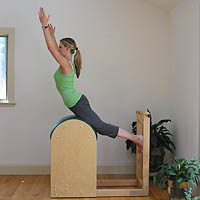
Ladder Barrel: The rounded barrel-shaped portion of this apparatus is separated from a four-rung ladder by a support base. This barrel is used to isolate the core muscles and to challenge the back in various planes of movement. Supported stretches lengthen and release the spinal muscles.
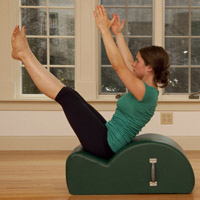
Spine Corrector: Shaped like half a keyhole laid flat on the floor, the Spine Corrector elongates the spine while stretching the chest. Supporting the spine in abdominal work allows greater and safer working range and allows for modifications for those with restrictions. Very effective leg strengthening is part of a complete series of exercises designed for this apparatus.

Mini Barrel: An upholstered arch, the Mini supports the back and shoulders during exercise, helps with postural correction and enhances breathing by opening the rib cage.

Magic Circle: Used often in a mat class, this flexible ring is used for isometric exercise to tone the arms and inner thighs. It helps keep the core connected to the midline when used between the legs.
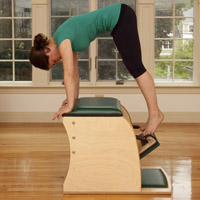
Wunda Chair: Created by Joseph Pilates, the Wunda Chair is basically a box with one side that can be pressed down against the resistance of springs, like a large pedal. More than 75 exercises can be performed on this compact and versatile piece of equipment.
History
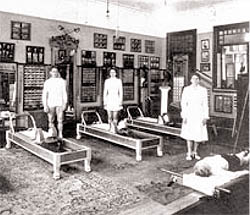 Pilates as an exercise method seems to have burst into the mainstream in the last fifteen years, but the system and the man who created the method and apparatus have a long and interesting history.
Pilates as an exercise method seems to have burst into the mainstream in the last fifteen years, but the system and the man who created the method and apparatus have a long and interesting history.
Joseph H. Pilates was born in 1880 in Germany. As a child he was small and sick, but determined to overcome his weaknesses. He studied diligently both the human anatomy and the movements of animals he watched in the woods. He learned both Eastern and Western physical conditioning systems, and the philosophies of subtle energies and mind-body connections. He wanted to know how to be strong, healthy and happy.
By the age of 14 he had worked so hard on his body that he was modeling for anatomy charts! He moved to England in 1912, where he toward the country as an athlete and performer, but World War I interrupted his path. In 1914 he was detained in a camp for enemy aliens. While there he began to develop a system of exercises as a physical fitness and athletics instructor. Having been transferred to another camp, he began working with bed-ridden patients suffering from wartime diseases and the effects of incarceration. There he rigged up exercise apparatus from bedsprings and pipes to rehabilitate them.
After the war he returned to Germany and worked as a physical trainer until he became disgruntled with the politics and decided to leave. On the boat trip to New York in 1926 he met is future wife and lifetime partner Clara and helped her conquer her arthritis pain. Landing in New York they found space in a building that housed several dance studios and set up a gym. They taught what they called “Contrology” and became well known there and later in the Berkshire Mountain arts centers for their work in strengthening, “”balancing””and rehabilitating dancers.
Joseph taught until his death 1967 at the age of 87 within a year of an injury from a fire in his studio. Clara continued to teach until her death ten years later. Several students of this innovative couple opened their own studios to carry on the techniques and teachings of the Pilates Method. One of those students attracted many Hollywood stars. Where the stars go the media follows. By 1980 the media was abuzz about this new exercise craze among the elite and famous and covered it extensively. It wasn’t long before the public noticed and “”Pilates” became popular. It continued in favor and its popularity exploded into the mainstream between 2000 and 2004. Pilates is now practiced by over ten million Americans!
Who Should Practice Pilates?
A recent study showed that the majority of clients seeking Pilates instruction were middle-aged women who did not participate regularly in other exercise activities and who had some complaint of musculoskeletal pain. The most desired goals were improved posture, flexibility, rehabilitation-related pain relief and treatment of musculoskeletal disorders. It doesn’t matter how old you are, how much you weigh or what level of physical fitness you have attained. A consistent Pilates practice will make you look good and feel great!
Dancers have known the benefits of Pilates for decades. More recently athletes have discovered how effective it is in improving strength, flexibility, performance and balance. It also plays an important role in injury prevention.
Individuals with chronic pain, especially low back pain and joint issues should be practicing Pilates regularly. It’s easy on the back and joints because it uses low impact movements in positions (often reclining or sitting) that reduce the effects of gravity. Pregnant women and new mothers benefit greatly and the exercises are safe.
Rehabilitation patients can recover more quickly and successfully to full function in their daily activities. Pilates developed his original equipment for bed-ridden patients. The method and exercises are safe, sensible and beneficial for those suffering from all kinds of conditions from disease to surgical recovery.
Many people in the US have poor or compromised posture from slumped computer postures to positions bent forward at work or at home to weakness from lack of exercise. Improved posture has many benefits including prevention of shoulder injuries, low back pain, repetitive stress injuries (RSI), neck pain and headaches.
Pilates helps with stress reduction. With its mind-body-spirit orientation and the focus that is required in practice, a state of mindfulness is created that has been medically proven to reduce stress. Wellbeing is also directly enhanced with effective and pleasurable exercise.
A Pilates practice improves general health and offsets the effects of aging. Joseph Pilates believed that mental and physical health are essential to each other. “”It is the mind itself which builds the body,””and that “”Physical fitness is the prerequisite of happiness”. He pointed out that when the 1918 epidemic of influenza struck his prison camp, not one of the detainees he was training contracted the disease.
BENEFITS
- Improves posture and alignment
- Relieves chronic pain
- Enhances athletic performance
- Balances and uniformly developed muscles
- Increases energy and ability to focus
- Decreases stress
- Improves general health, immunity and fitness
- Increases strength without bulk
- Increases flexibility, range of motion and agility
- Develops long, lean toned muscles and a flat abdomen
- Prevents injuries
- Increases speed of recovery from hard workouts
- Decreases joint damage and eases joint movement
- Improves confidence in exercising safely
- Eases childbirth and accelerates post delivery recovery
- Speeds and improves rehabilitation from surgical conditions, injury and disease
MORE BENEFITS
- Eases the effects of aging
- Improves coordination
- Increases balance and stability
- Stimulates circulation and increases lung capacity
- Increases core strength and peripheral mobility
- Improves bone density
- Improves body image
- Alleviates and prevents back pain
- Increases core strength
- Increases efficiency and economy of motion
- Teaches body awareness, good posture and easy, graceful movement
- Gets your mind in tune with your body
- Creates an evenly conditioned body
- Teaches safer more efficient patterns of motion
- Promotes increased circulation of energy and blood, stimulating an “internal cleansing”
- Improves health of the spine
